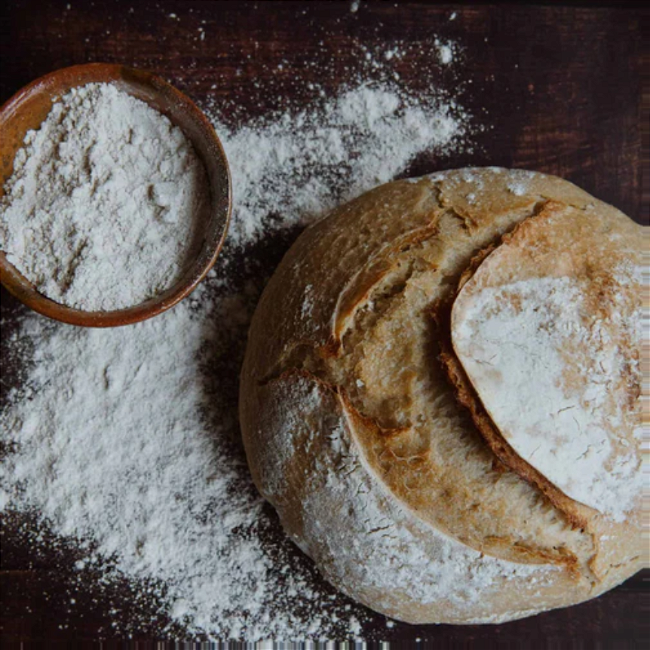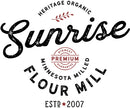The jar we sell weighs 420g

Ingredients
1000 g Heritage White Flour or Heritage Bread Blend (*These two flours are easy to work with and will make great bread to get you started. After you get familiar with this process you can use this same recipe to replace some of the flour Heritage White Flour or Heritage Bread Blend Flour with Heritage Whole Wheat Flour or Rye Flour to make whole wheat or rye bread).
720 g Water, chlorine-free, 90F (if you have city water you can boil it and let sit for 24 hours)
1 tbsp (20 g) Salt - Real Salt or other unrefined salt
250-300 g Active sourdough starter
Directions
Tip: if your starter is watery and runny, use less water. If your starter is thick, you can increase your water.
Presoak the flour by combining all 1000g of flour with all 720g of water. Mix for 3-5 minutes into a shaggy dough, then cover for one hour (this is called an autolyze).
After the presoak, add the salt to the dough and mix enough to combine it. Add the sourdough starter and mix thoroughly. After about 3 minutes of vigorous mixing, it should start to look like bread dough. After 3 minutes of mixing with a dough whisk, switch to your hands and mix for another minute or until you have a smooth bread dough.
Tip: wet your hands to help the dough not stick. If you flour your hands, you risk incorporating too much flour into the dough.
Mixing the sourdough into the pre-soaked flour is a little challenging part of this recipe. It can be done by hand or mixer. By hand you should use the “pincer method” of pinching and turning the dough. If you use a mixer, you may have to stop the mixer and use a wooden spoon to stir the pre-soaked dough and starter together. This will help the starter and presoak begin to combine and then you can continue mixing. Once you get the combination started with a wooden spoon, the mixer will be much more successful.
When mixed into a smooth bread dough, place the dough in a large mixing bowl and cover for a bulk ferment of several hours depending on the temperature of the room. If the temp is more than 70F it will double in size in a few hours. If it is less than 70F, it will take longer so keep an eye on it.
Once about doubled in size, stretch and fold by grabbing the dough and pulling it up and toward the center in four stretches at 90 degrees each, top, left, bottom, right. Cover and repeat the same stretch and fold in twenty minutes. (The dough needs twenty minutes to relax between stretch and folds). You can decide how many stretch and folds to do, anywhere from 2-5 is common. The dough will get stronger with each stretch and fold.
Divide into two equal portions, shape and place in bannetons (or greased bowls), or greased bread pans. Cover with a plastic bag and place in the refrigerator for 12 hours.
After the 12 hours, If the dough looks fully proofed (has nearly doubled in size) you can bake it right away. If it looks like it could use more proofing time, keep it in the plastic wrap and set it on the counter to proof a bit more before baking.
Heat oven to 425F – 450F. If you are using a Dutch oven, place the Dutch oven in the oven when you start the preheat. A good half hour preheat is required for Dutch ovens.
Dutch oven method - slash the dough with a razor blade and place it in the preheated Dutch oven. Cover and bake for about 25 minutes. For a darker crust, remove the cover from the Dutch oven after 15 minutes.
Bread pan method - slash the dough and place in the oven. Reduce the heat to 350F and bake for about 40 minutes. For a darker crust, cover the pan with foil and remove the last 10-15 minutes. For a softer (and lighter) crust, cover the loaf the whole time.
At the end of the bake time check the inside temperature of bread with a thermometer. It should read 195-205F when done.
Remove from pan or Dutch oven immediately and let cool on a rack that will allow air to circulate under the bread.
It is important to understand that it takes practice to get the feel of sourdough baking. If you are not getting the results you desire, you can increase the amount of starter or adjust the hydration. Every time you combine flour, water, salt, and starter, it is an experiment so have fun with it.













